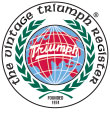TR6 Diff Mount Bracket Diagnosis and Repair
by Kenneth Streeter,
with input from Roger Bolick, Scotty Paisley and various sources
It is a quite common problem for the TR6 to develop a “clunk” from the rear of the car when you suddenly apply power to the drivetrain (like when you accidentally “drop” the clutch). If replacing the driveshaft and half-axle u-joints doesn’t cure this problem (the most common cause), then it is quite likely that you may have the dreaded broken diff mount bracket.
Basically, the diff mounts frequently crack after years of stress, primarily because they weren’t strong enough in the first place. The noise caused by this starts off as an occasional “clunk” when letting the clutch up too quickly, but eventually progresses to a “clunk” on every sudden application (or removal) of power to the drivetrain. If you hear this, don’t put off the repair — if you catch it right away, you may only have to replace the rubber diff mounts. If you wait too long, you’re in for frame repairs.
The mount bracket that breaks first is the front right (passenger side on US-spec cars) mount. Due to the diff geometry, this one mount bracket, made of only relatively thin metal, takes the brunt of the torque applied to the diff by the driveshaft.
To check the mount bracket, and the condition of the rubber mounts, get the car well up on jackstands, and make sure it is rock solid there. (This is very important — you do not want to have the car fall off the jackstands while you are under it.) Have the car turned off, in 1st gear, with the parking brake off. Get under the car, and shine a light up at the diff mounts. If there is visible wear to the rubber differential mounts, replace them. Worn out rubber mounts is a major contributing factor to cracked diff mount brackets. You may be lucky, and caught the problem before you developed a crack.
As added protection, the stock rubber mounts can be upgraded to polyurethane mounts. (These are available from British Parts North West, and possibly other suppliers as well.) The poly mounts will not shrink over time like the rubber mounts — the typical shrinkage of the rubber mounts allows the differential to twist, banging the right front mount upon each start of the car from a stop, causing the mount to break.
Even if your rubber mounts seem to be in good shape, examine the mount brackets on the frame thoroughly for visible cracks. Feel the top side of the mount brackets carefully. If there is a crack there, you may be able to feel it, even if you can’t see it — your fingertips are quite sensitive, even with the years of grunge that will be up there. (I hope you don’t mind getting your hands dirty!)
For an alternate perspective to give you a better view of the front right mount, take off the right rear wheel, and inspect the mount through the wheel well. From this angle, you’ll easily be able to see the diff mount brackets and run your finger over them to feel for a crack.
As a further check, particularly if you aren’t sure about the condition of the rubber mounts, have an assistant abruptly turn one of the rear wheels while you are laying on your back, under the car, looking up at the diff. Keep your hands clear from the axles and driveshaft while this is done. The intent of the helper is to suddenly start (jolt) the wheel to turn, and then stop it equally abruptly. The helper shouldn’t let go of the wheel, but should grab it firmly with both hands, suddenly turn it about a quarter turn as abruptly as they can, and stop it equally abruptly. The intent here is to apply a jolt to the drivetrain. (Don’t worry about hurting it — a person “jolting” the wheel as hard as they possibly can won’t apply a jolt even half as severe as even a smooth start in first gear.)
When this is done, the other rear wheel will spin in the opposite direction (since the tranny is in gear). There will also be a sudden rotational jolt to the diff when the wheel is started and stopped. There should be only very little movement of the diff on its mounts. If there is significant movement, you definitely should replace the diff mounts ASAP, and may find a cracked mount bracket (probably the front right mount).
A cracked mount can be fixed by a competent welder by welding a re-inforcing plate at the top section of the mount bracket, another at the bottom section of the mount bracket, and by boxing the mount bracket in on both sides. The Roadster Factory sells pre-cut pieces for boxing in the mounts, but they can also be fabricated by most welders. If you have pieces fabricated, make sure that large holes are drilled in the fabricated pieces, so that air flow gets to the boxed-in section to allow moisture to escape.
When I went to order the reinforcements in April of 1997, TRF was out of stock on these reinforcements, so they sent me a diff mount reinforcement template . (This file is in Microsoft Word ’97 format.)
I recently had the above frame repairs performed and polyurethane mounts installed on my ’74 TR6, and am happy with the results.
Ken Streeter, streeter@www.vtr.org
